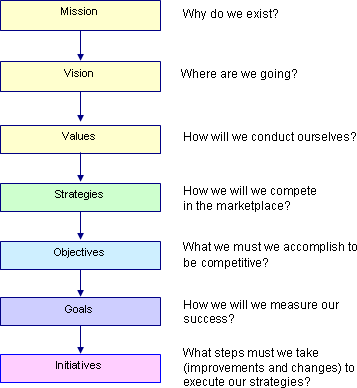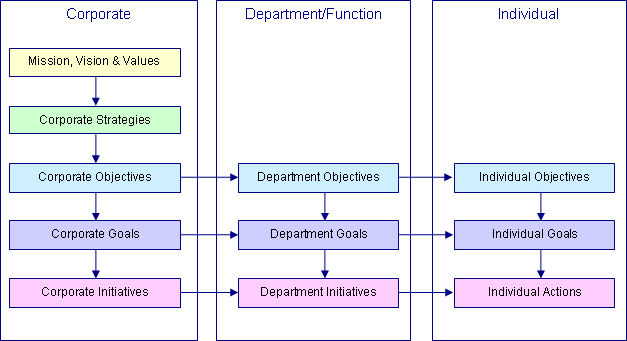Let me cut through the clutter to offer a simple framework for strategic planning that will turn your strategic plans into the results you want.
The basic philosophy is that if you are going to work on a strategic plan, your plan should work for you. I have found that rather than debating what specific terms mean, it is simpler and faster to answer important questions about your strategy. You will see these questions noted to the right of each planning component.

Using this framework, there are three phases: prepare, design and execute.
Prepare
Your strategic plan is a primary vehicle for achieving your goals. Therefore, a useful strategic plan requires significant preparation to help ensure your return on investment. First, identify lessons learned from past strategic planning sessions. Ask yourself, "What should we stop, start and keep for our upcoming planning?".
Next, define what you want to achieve with your strategic plan. Do you want to:
- Fine-tune your business
- Maximise untapped opportunities; or
- Transform your business due to rapid changes?
Finally, collect data so your team can spend their strategic planning time interpreting data rather than debating perceptions. Conduct a SWOT (Strength, Weaknesses, Opportunities and Threats) analysis on your customers, markets, competitors, industry, environment and organisational capabilities - skills, culture, structure, direction, agility, etc.
Design a process
Many leaders view strategic planning as an event instead of a process. Here are three practical ways to design a strategic planning process that focuses on execution.
- Hold quarterly strategic reviews
Use them to take a look back at how you performed against your strategic plan and to take a look forward to what you need to get / stay on track
- Create a rolling plan
At each quarterly business review, add a new quarter to your plan. Rolling plans are more commonly used in budget planning, but they can be equally useful for creating a strategic planning process
- Clearly define and manage your performance indicators
Every organisation has a variety of performance indicators. Consider a measurement continuum (see graphic below). The two ends of the continuum represent the two types of performance indicators:
- Lagging indicators
Are the results of your organisation's past performance - they enable you to see if your plans worked as well as expected
- Leading indicators
Are the drivers of your organisation's future performance - they give you early warning signs of problems
Economic engines force most leaders to focus on lagging indicators - typically financial ones. These lagging indicators are important to help you understand how you have performed in the past. However, they must be balanced with leading indicators that tell you how your organisation will perform six, nine or twelve months from now.
A singular focus on lagging indicators gives you little opportunity for corrective action if your team drifts off course. Effective leaders look at both lagging and leading indicators of performance. This balanced view enables them to know what did happen and also anticipate what will happen.
Execute!
This step never ends. Your organisation's ability to execute your strategic plan will determine your competitive advantage. Research from Fortune's Most Admired companies reveals that top companies set themselves apart because strategy is not an exercise; it is the focus of everything they do. Execution is easy to talk about - but difficult to do. Here are four tips to help you stick to your strategic plan:
- A clear leadership focus (and the resulting organisational focus) is a common theme for the most successful companies. Therefore, define one thing you will focus on to drive your strategic plan - keep it simple. Communicate your strategy tirelessly and shamelessly.
- Review your strategic initiatives, and create a "stop doing list". Identify those activities, tasks, reports, meetings and projects that do not directly support your strategy. Interestingly, your "stop doing list" often has a bigger impact on your organisation's ability to focus than the list of "to-do's". Your time, energy and money are precious resources - if you spend them in one area, they are not available to be spent in another area. Communicating this message deep into your organisation enables employees to say "No" to non-value-added tasks and stay focused on executing your plan. Saying "Yes" to one thing always means saying "No" to something else.
- Ensure that each initiative has a single point of accountability. Remember, company performance is just a concept that is brought to reality by individual performance. The strategic rubber meets the road of execution at the individual level.
- Many companies are challenged to get their strategies communicated and executed down to the departmental level, let alone getting it all the way down to the individual level. The graphic below illustrates how to cascade your strategy from the corporate to the departmental to the individual level.

From possibilities to performance
At the beginning of the day it's all about possibilities. At the end of the day, it's all about performance. Almost all companies consider the possibilities, but only winners turn possibilities into performance.